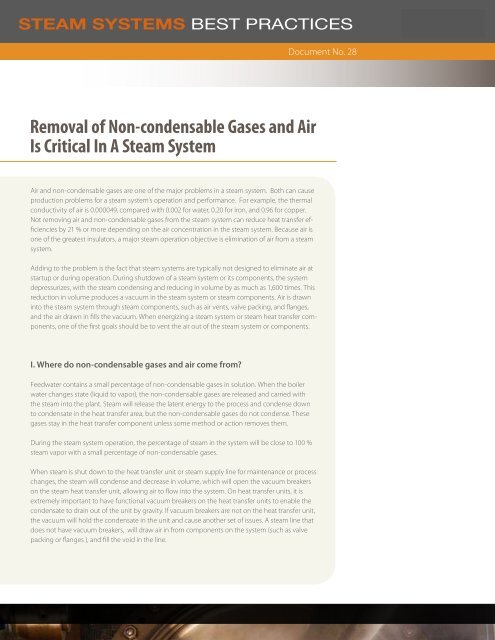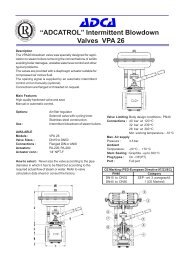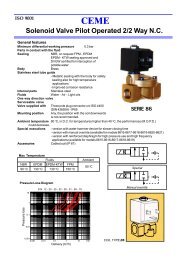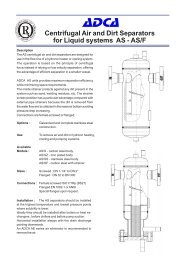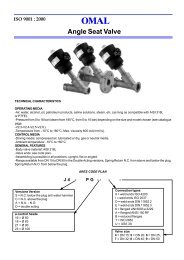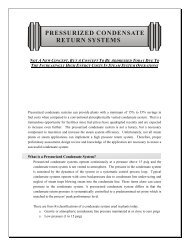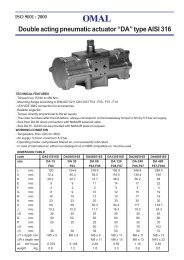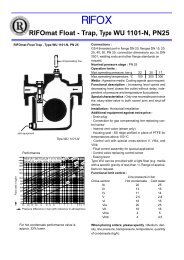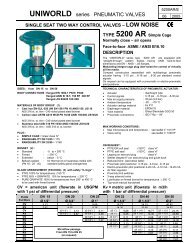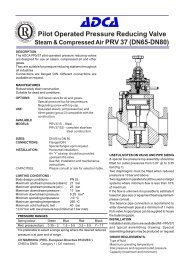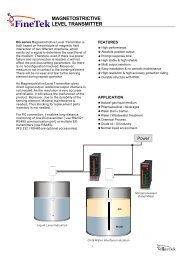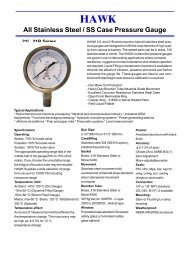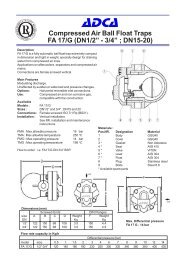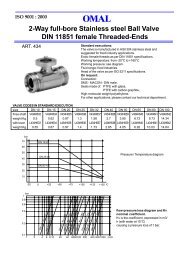Removal of Non-condensable Gases and Air Is Critical In A Steam ...
Removal of Non-condensable Gases and Air Is Critical In A Steam ...
Removal of Non-condensable Gases and Air Is Critical In A Steam ...
Create successful ePaper yourself
Turn your PDF publications into a flip-book with our unique Google optimized e-Paper software.
STEAM SYSTEMS BEST PRACTICESSwagelok Energy Advisors, <strong>In</strong>c. Document No. 28<strong>Removal</strong> <strong>of</strong> <strong>Non</strong>-<strong>condensable</strong> <strong>Gases</strong> <strong>and</strong> <strong>Air</strong><strong>Is</strong> <strong>Critical</strong> <strong>In</strong> A <strong>Steam</strong> System<strong>Air</strong> <strong>and</strong> non-<strong>condensable</strong> gases are one <strong>of</strong> the major problems in a steam system. Both can causeproduction problems for a steam system’s operation <strong>and</strong> performance. For example, the thermalconductivity <strong>of</strong> air is 0.000049, compared with 0.002 for water, 0.20 for iron, <strong>and</strong> 0.96 for copper.Not removing air <strong>and</strong> non-<strong>condensable</strong> gases from the steam system can reduce heat transfer efficienciesby 21 % or more depending on the air concentration in the steam system. Because air isone <strong>of</strong> the greatest insulators, a major steam operation objective is elimination <strong>of</strong> air from a steamsystem.Adding to the problem is the fact that steam systems are typically not designed to eliminate air atstartup or during operation. During shutdown <strong>of</strong> a steam system or its components, the systemdepressurizes, with the steam condensing <strong>and</strong> reducing in volume by as much as 1,600 times. Thisreduction in volume produces a vacuum in the steam system or steam components. <strong>Air</strong> is drawninto the steam system through steam components, such as air vents, valve packing, <strong>and</strong> flanges,<strong>and</strong> the air drawn in fills the vacuum. When energizing a steam system or steam heat transfer components,one <strong>of</strong> the first goals should be to vent the air out <strong>of</strong> the steam system or components.I. Where do non-<strong>condensable</strong> gases <strong>and</strong> air come from?Feedwater contains a small percentage <strong>of</strong> non-<strong>condensable</strong> gases in solution. When the boilerwater changes state (liquid to vapor), the non-<strong>condensable</strong> gases are released <strong>and</strong> carried withthe steam into the plant. <strong>Steam</strong> will release the latent energy to the process <strong>and</strong> condense downto condensate in the heat transfer area, but the non-<strong>condensable</strong> gases do not condense. Thesegases stay in the heat transfer component unless some method or action removes them.During the steam system operation, the percentage <strong>of</strong> steam in the system will be close to 100 %steam vapor with a small percentage <strong>of</strong> non-<strong>condensable</strong> gases.When steam is shut down to the heat transfer unit or steam supply line for maintenance or processchanges, the steam will condense <strong>and</strong> decrease in volume, which will open the vacuum breakerson the steam heat transfer unit, allowing air to flow into the system. On heat transfer units, it isextremely important to have functional vacuum breakers on the heat transfer units to enable thecondensate to drain out <strong>of</strong> the unit by gravity. If vacuum breakers are not on the heat transfer unit,the vacuum will hold the condensate in the unit <strong>and</strong> cause another set <strong>of</strong> issues. A steam line thatdoes not have vacuum breakers, will draw air in from components on the system (such as valvepacking or flanges ), <strong>and</strong> fill the void in the line.SWAGELOK ENERGY ADVISORS, INC. | WWW.SWAGELOKENERGY.COM | 888-615-3559 | SEATECHNICALSERVICE@SWAGELOK.COM
STEAM SYSTEMS BEST PRACTICESSwagelok Energy Advisors, <strong>In</strong>c. Document No. 28II. How does air affect the system?A. <strong>Air</strong> Reduces the Heat Transfer EfficiencyThe release <strong>of</strong> latent energy (change <strong>of</strong> state) to condensate in the steam components takesplace on the heat transfer surface, which is where heat is being transferred due to thetemperature difference (steam to the process). The steamcomponent transfer is consuming the latent energy,<strong>and</strong> the steam is condensing to a liquid (condensate);the condensate is drained away by gravity, but the non<strong>condensable</strong>gases <strong>and</strong> air remain.The non-<strong>condensable</strong> gases form a stagnant film on thewalls <strong>of</strong> the heat transfer surface which creates aresistance. Heat energy transmitting through the heattransfer surface has to pass by conduction throughthese films <strong>of</strong> resistance. A film <strong>of</strong> air or non-<strong>condensable</strong>gases that is only one thous<strong>and</strong>th <strong>of</strong> an inch thick has theresistance <strong>of</strong> a three-inch wall <strong>of</strong> iron. See Figure 1.Figure 1 Resistance <strong>of</strong> <strong>Air</strong> Compared to Copper <strong>and</strong> IronThe latent heat energy <strong>of</strong> steam must pass from thesteam heat transfer area to the area where the processmaterial is being heated. To do so, it must pass throughseveral obstacles:1. A stagnant film <strong>of</strong> air/steam on the steam side2. Condensate film3. Buildup <strong>of</strong> rust or corrosion material4. Heat transfer metal wall5. Product side—burned product or scale6. Stagnant film <strong>of</strong> material on the process side <strong>of</strong>the wallB. <strong>Air</strong> Reduces the Temperature <strong>of</strong> <strong>Steam</strong>1. Dalton’s Law <strong>of</strong> Partial PressuresDalton’s law <strong>of</strong> partial pressures states that inFigure 2 Obstacles to Energy Transfera mixture <strong>of</strong> gases or vapors, the total pressure <strong>of</strong>the mixture is made up <strong>of</strong> the partial pressures exerted by each gas or vapor. The partialpressure exerted by each is the fraction <strong>of</strong> the total pressure equal to the fraction <strong>of</strong> thetotal volume <strong>of</strong> each.The pressure reading is in absolute units. For example, the total pressure <strong>of</strong> a mixture <strong>of</strong>25 % air <strong>and</strong> non-<strong>condensable</strong> gases <strong>and</strong> 75 % steam is 114.7 lbs. per sq. in. absolute(337.87°F).The partial pressure <strong>of</strong> steam is 114.7 x 0.75 or 86.02 lbs. per sq. in. absolute (psia) (317°F).SWAGELOK ENERGY ADVISORS, Figure 3 INC. | WWW.SWAGELOKENERGY.COM | 888-615-3559 | SEATECHNICALSERVICE@SWAGELOK.COM
STEAM SYSTEMS BEST PRACTICESSwagelok Energy Advisors, <strong>In</strong>c. Document No. 28with a very low sub-cool. The device is able to sense air or non-<strong>condensable</strong> gases due tothe resulting temperature suppression.The air venting device is used on the heat transfer units that have shutdowns <strong>and</strong>startups during the operational week.Negative:a. Reliability can be a issue if the proper air venting device is not purchasedPositives:a. No plant personnel have to be at the location during startupb. Greatly improves the operation <strong>of</strong> the heat transfer system4. <strong>Steam</strong> Trap<strong>Steam</strong> traps are never considered to be primary air venting mechanisms due to themethods incorporated into their design to accomplish this task. Therefore, steam trapsare always considered secondary air vent mechanisms. There are two methods to vent airin any steam trap: a leak path <strong>and</strong> a thermostatic mechanism.A. Create a leak pathThe steam trap design has a leak path incorporated into the operational design. Thesteam trap leak path is very small to ensure no significant steam loss occurs duringoperation. Due to the small leak path, the steam trap is not able to provide sufficient airventing capabilities.B. Thermostatic mechanismThe other method is to use a thermostatic element inside <strong>of</strong> the steam trap that can <strong>of</strong>fera high capacity <strong>of</strong> venting air at startup due to the orifice size. <strong>In</strong> process applications, thepreferred steam trap is a float <strong>and</strong> thermostatic steam trap, which incorporates athermostatic air venting mechanism. Plants <strong>of</strong>ten employ one or more <strong>of</strong> the above itemsto remove the air from the steam system during startup oroperation.IV. <strong>In</strong>stallation <strong>of</strong> <strong>Air</strong> Venting <strong>and</strong> DevicesA. <strong>Steam</strong> LinesWhen steam lines are activated or started up, one <strong>of</strong> the main tasks isto remove the non-<strong>condensable</strong> gases. During startup, the drain valve<strong>of</strong>f the steam line drip pocket is opened, venting air from the steam line<strong>and</strong> removing condensate. <strong>In</strong> some cases, a second manual air ventingvalve is installed on top <strong>of</strong> the steam line to ensure removal <strong>of</strong> air fromthe system. See Figure 4.Note: the strainer blowdown valve is also open at startup to allow the strainer to be blown down.Figure 4 <strong>Steam</strong> LinesSWAGELOK ENERGY ADVISORS, INC. | WWW.SWAGELOKENERGY.COM | 888-615-3559 | SEATECHNICALSERVICE@SWAGELOK.COM
STEAM SYSTEMS BEST PRACTICESSwagelok Energy Advisors, <strong>In</strong>c. Document No. 28B. Examples <strong>of</strong> Process Equipment Placement <strong>of</strong> <strong>Air</strong> Vents <strong>and</strong>Vacuum BreakersA key factor in the location <strong>of</strong> air vents on process equipment is to underst<strong>and</strong>the design <strong>of</strong> the unit. For example, a shell <strong>and</strong> tube heat exchanger has a porttypically on the top <strong>of</strong> the shell for the placement <strong>of</strong> a vacuum breaker <strong>and</strong> airvent. The process steam side needs to have the air purged to ensure properstartup <strong>and</strong> temperature control. See Figure 5.<strong>Steam</strong> coils have a vacuum breaker located at the entrance <strong>of</strong> the steam intothe coils, usually located on the port on the top header <strong>of</strong> the device. SeeFigure 6.For process application steam traps, the preferred steam trap design is thefloat <strong>and</strong> thermostatic, which incorporates a thermostatic air vent mechanism.The steam trap thermostatic air vent mechanism becomes the secondaryair venting device.Figure 5 Shell <strong>and</strong> Tube Heat ExchangerRoadmap:1. Survey all process equipment <strong>and</strong> ensure units have air vents <strong>and</strong>vacuum breakers.2. Survey all steam line drip legs <strong>and</strong> ensure proper blowdown valvesare installed.3. Have St<strong>and</strong>ard Operating Procedures (SOP) for the use <strong>of</strong> manualair vents on steam lines <strong>and</strong> process applications.Figure 6 <strong>Steam</strong> CoilsSwagelok – TM Swagelok Company © 2010 Swagelok CompanySWAGELOK ENERGY ADVISORS, INC. | WWW.SWAGELOKENERGY.COM | 888-615-3559 | SEATECHNICALSERVICE@SWAGELOK.COM


